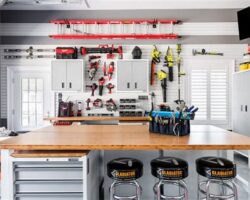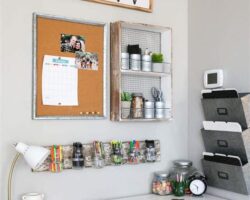Are you tired of the constant noise in your workshop? Do you find it hard to concentrate and be productive with all the loud machinery and tools? If so, you’re not alone. Excessive noise in a workshop can not only be annoying, but it can also have a negative impact on your health and overall well-being. In this blog post, we will explore various soundproofing techniques to help you reduce the noise in your workshop. From identifying the sources of workshop noise to choosing the right soundproofing materials and implementing effective solutions, we’ve got you covered. Whether you’re dealing with loud machinery or noisy tools, we’ll discuss specific soundproofing techniques to address each issue. By maintaining and optimizing soundproofing measures, you can create a much quieter and more conducive work environment. Say goodbye to the constant racket and hello to a peaceful workshop with our soundproofing tips and techniques.
Identifying the sources of workshop noise
When working in a workshop, it’s important to be aware of the various sources of noise that can impact your health and productivity. One common source of noise in a workshop is machinery, such as saws, presses, and drills. These machines can generate high levels of noise that can contribute to hearing damage over time. Another source of noise is impact tools, such as hammers and pneumatic tools, which produce loud, sudden bursts of sound. In addition, workshop equipment like compressors and ventilation systems can also be significant sources of noise in the workshop.
Identifying these sources of noise is the first step in addressing the issue and implementing appropriate soundproofing measures. By understanding where the noise is coming from, you can take targeted action to reduce its impact on your working environment.
Regular noise assessments and monitoring can help to pinpoint the specific sources of noise in your workshop. This may involve using noise meters to measure sound levels and identify the loudest areas of your workspace. Once you have identified the main sources of noise, you can then begin to explore effective soundproofing solutions to mitigate their impact.
By accurately identifying the sources of workshop noise, you can take proactive steps to create a quieter, more comfortable working environment for yourself and your colleagues.
Understanding the negative impact of excessive noise
Excessive noise in the workshop environment can have serious repercussions on the health and well-being of workers. Prolonged exposure to high levels of noise can lead to hearing loss, which is irreversible and can significantly impact an individual’s quality of life. In addition to hearing damage, excessive noise can also increase stress levels, disrupt communication, and impair concentration and productivity.
Furthermore, excessive noise can have adverse effects on physical health, such as causing headaches, fatigue, and even cardiovascular issues. It can also interfere with sleep patterns, leading to sleep disturbances and associated health problems. The negative impact of excessive noise extends beyond the individual level and can affect the overall work environment and employee morale.
Understanding the negative impact of excessive noise is crucial for implementing effective soundproofing solutions to safeguard the well-being of workers and optimize productivity in the workshop setting. By recognizing the detrimental effects of excessive noise, organizations can prioritize the importance of soundproofing measures and create a safer and more conducive work environment for all.
It is essential to raise awareness about the consequences of excessive noise exposure, as well as educate individuals about the benefits of soundproofing in mitigating these effects. Through proactive efforts to address excessive noise, organizations can demonstrate their commitment to employee health and safety, ultimately fostering a more positive and productive work environment.
Choosing the right soundproofing materials
When it comes to soundproofing a space, whether it’s a workshop, office, or home, choosing the right soundproofing materials is crucial. The first step in this process is to assess the specific needs of the space. For example, is the main concern to reduce outside noise from coming in, or to minimize noise transmission within the space itself?
Once the specific needs have been determined, it’s important to consider the different types of soundproofing materials available. Mass-loaded vinyl (MLV) is a popular choice for soundproofing, as it is a dense, flexible material that can be used to block sound transmission. Another option is acoustic foam panels, which are designed to absorb and reduce sound reflections within a space.
It’s also important to consider the installation and maintenance requirements of different soundproofing materials. Some materials may be easier to install than others, and some may require more frequent maintenance to remain effective. Additionally, the cost of materials should be taken into account, as certain options may be more budget-friendly than others.
Ultimately, choosing the right soundproofing materials involves carefully considering the specific needs of the space, researching the different options available, and weighing factors such as installation, maintenance, and cost.
Implementing effective soundproofing solutions
When dealing with excessive noise in a workshop environment, it is essential to implement effective soundproofing solutions to ensure a safe and productive work environment. One of the most important steps in this process is identifying the sources of workshop noise. This involves identifying the specific machinery or tools that are producing the noise, as well as any structural elements of the workshop that may contribute to noise transmission.
Once the sources of noise have been identified, the next step is choosing the right soundproofing materials to address the problem. This may involve using materials such as acoustic foam, mass-loaded vinyl, or soundproof curtains to absorb or block the transmission of noise. It is important to select materials that are appropriate for the specific type of noise and frequency range being produced.
After selecting the appropriate materials, the next step is utilizing acoustical barriers to reduce noise transmission. This may involve installing barriers such as soundproof panels or baffles to redirect or absorb noise, as well as sealing any gaps or openings in the workshop structure that may allow noise to escape.
Finally, it is important to continuously maintain and optimize soundproofing measures to ensure they remain effective over time. This may involve regular inspections and repairs to soundproofing materials, as well as periodic adjustments to the layout of the workshop to minimize noise transmission.
Utilizing acoustical barriers to reduce noise transmission
Noise transmission in workshops can be a significant issue, affecting the productivity and well-being of workers. Utilizing acoustical barriers is a key strategy to reduce the impact of noise. These barriers can be employed in various forms, such as soundproof curtains, acoustic enclosures, and noise barriers. By utilizing these acoustical barriers, workshops can effectively reduce the transmission of noise, creating a more comfortable and productive work environment.
One effective form of acoustical barrier is the use of soundproof curtains. These curtains are designed to absorb and block sound, preventing noise from traveling through the workshop. By strategically placing these curtains in areas where noise is most concentrated, such as around machinery or workstations, workshop owners can significantly reduce the impact of noise transmission.
Another method of utilizing acoustical barriers is through the use of acoustic enclosures. These enclosures are designed to contain noisy machinery or equipment, preventing the spread of noise to other areas of the workshop. By enclosing loud machinery with acoustic barriers, such as soundproof panels, workshop owners can effectively reduce the overall noise level within the workspace.
Noise barriers are another effective way to utilize acoustical barriers to reduce noise transmission. These barriers can be installed around the perimeter of a workshop or in specific areas to block and absorb sound. By strategically placing these barriers, workshops can create a quieter and more conducive working environment, ultimately improving the overall productivity and well-being of workers.
Soundproofing techniques for specific machinery or tools
When it comes to soundproofing techniques for specific machinery or tools, it’s important to first identify the primary sources of noise. Whether it’s a loud generator, a rattling conveyor belt, or a booming industrial saw, pinpointing the exact source of the noise is crucial in determining the most effective soundproofing solutions.
Once the sources of noise have been identified, it’s essential to understand the negative impact of excessive noise on both workers and the surrounding environment. Prolonged exposure to high levels of noise can lead to hearing damage, stress, and decreased productivity. This underscores the importance of implementing effective soundproofing measures for specific machinery or tools.
Choosing the right soundproofing materials is another crucial step in reducing noise from specific machinery or tools. Whether it’s acoustic foam, soundproof curtains, or vibration isolation pads, selecting the appropriate materials can significantly impact the overall effectiveness of the soundproofing solution.
Finally, implementing soundproofing solutions for specific machinery or tools involves utilizing acoustical barriers to reduce noise transmission. This may include installing soundproof enclosures, isolating vibrating equipment, or applying sound-absorbing panels to minimize noise levels.
Maintaining and optimizing soundproofing measures
When it comes to maintaining and optimizing soundproofing measures, regular inspections and maintenance are key. Over time, soundproofing materials can degrade or become damaged, which can compromise their effectiveness. It’s important to schedule routine checks of all soundproofing materials in the workshop to ensure they are in good condition. This includes checking for cracks, holes, or wear and tear that may have developed over time.
Additionally, optimizing soundproofing measures involves staying informed about the latest advancements in soundproofing technology. With new materials and techniques constantly being developed, workshops can benefit from staying up to date and implementing the latest innovations to maximize their soundproofing efforts.
An integral part of maintaining soundproofing measures is addressing any issues as soon as they arise. Whether it’s repairing damaged materials or investing in new and improved soundproofing solutions, taking prompt action can prevent sound leakage from causing disruptions in the workspace.
Regular maintenance and staying current with soundproofing advancements are crucial steps in maintaining and optimizing soundproofing measures in a workshop environment, ultimately contributing to a more peaceful and productive work environment.





